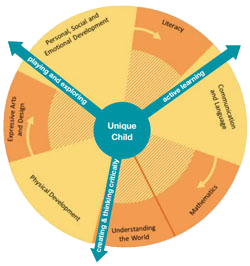It is highly important that children’s development is tracked across the EYFS, there is clear guidance stated in the EYFS that practitioner are to identify how children are progressing and document this for others to see. Documenting children’s progress enables parents and other professionals to recognise the child’s progress and also highlights and areas for concern.
There are different forms are assessing children’s development, a, summary of a child’s achievements at a particular point in time so that their progress can be tracked is known as summative assessment. Formative assessments consists of annotated photographs, spontaneous and planned observations, information from parents, samples of children’s experiences, all of these will build up a picture so that the practitioners can make a best fit judgement of where the child is working at in relation to the EYFS age bands.
Formative assessments enable practitioners to plan the provision and meet the needs of the children’s interests and next steps; this type of assessment is ongoing all day as practitioners are gathering evidence through observations which will then feed into the planning. Assessments such as the Progress Summaries and Tracking documents are a summative assessment that is best completed together.
Progress Summary
A progress summary document enables practitioners to summaries children’s development across the Prime and Specific areas of the EYFS, it identifies how children are making sufficient progress in a particular area and it can help parents understand how their child is learning. As children from the age of two receive a development two year check carried out by a professional some settings use the progress summary document 0-36 months as a great tool to share during the two year progress check. This creates less paperwork for practitioners as the information for both the two year progress check and the progress summary are identical.
For more information the 2 year progress check CLICK HERE
On Entry assessment (starting points)
On entry assessments are a great way to identify children’s starting points and to have information to use to help plan suitably experiences. Communication with parents is key in this process as they hold the information on their child’s learning development, All about me sheets that are completed by parents give practitioners small snapshot of information about the child. Over a period of two weeks practitioners should complete an individual tracker, taking into considerations parents information’s and observations. The key person should make a judgement against each aspect and indicate whether the child is beginning, consolidating or secure, some setting use other words that mean the same but still convey the same principle. The individual tracker is then completed over set times across the year, it is completed in the same way as on entry assessment.
Some helpful hints and tips
- Settings should agree a time to complete the children’s individual tracking sheets
- A key is needed to be used to help identify the date when a child’s progress is recorded and also the child’s current age in months should be recorded.
- The individual progress tracker should show the children’s leaning and development across the prime and specific areas
Cohort Tracker
The Cohort tracker collates all children’s tracking in one place; it enables managers to ask questions about a number of things, the provision, practice and specific questions on particular children’s progress. Managers may identify trends and patterns and to help address this appropriate measures and intervention will be implemented to support the children and help them make significant progress
Some settings have an individual progress tracker, a key group progress tracker sheet and then this information is then added to a cohort tracker which shows all children’s information from across the nursery.
Some helpful hints and tips
- Agree times to complete the Cohort tracker across the year
- Managers to consider how best to collate the data for example some settings may use one Cohort tracker per key group, or per year group, this will depend upon the size of the setting.
- Look at ways of using the information in the cohort tracker to make a significant impact on the environment, children progress or practitioner practice.
- Think about using different coding for identified specific groups eg EAL, SEND, 2 Year funded etc
- Managers need to analyse the data to identify patterns or trends.
- Changes to environment or practice need to be implemented to meet the needs of the children

